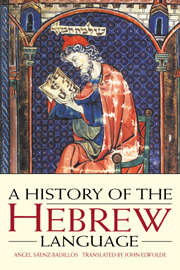Book contents
- Frontmatter
- Contents
- Foreword by Shelomo Morag
- Acknowledgements
- 1 Hebrew in the context of the Semitic languages
- 2 Hebrew, a Northwest Semitic language
- 3 Pre-exilic Hebrew
- 4 Biblical Hebrew in its various traditions
- 5 Hebrew in the period of the Second Temple
- 6 Rabbinic Hebrew
- 7 Mediaeval Hebrew
- 8 Modern Hebrew
- Bibliography
- Index
5 - Hebrew in the period of the Second Temple
Published online by Cambridge University Press: 05 June 2012
- Frontmatter
- Contents
- Foreword by Shelomo Morag
- Acknowledgements
- 1 Hebrew in the context of the Semitic languages
- 2 Hebrew, a Northwest Semitic language
- 3 Pre-exilic Hebrew
- 4 Biblical Hebrew in its various traditions
- 5 Hebrew in the period of the Second Temple
- 6 Rabbinic Hebrew
- 7 Mediaeval Hebrew
- 8 Modern Hebrew
- Bibliography
- Index
Summary
Post-exilic Biblical Hebrew
The Babylonian exile marks the beginning of a new stage in the development of Hebrew. The spoken and written languages had been drifting apart before the exile, and the social and political turmoil brought about by the fall of Jerusalem and the destruction of the First Temple produced a significant change in the linguistic status quo to the detriment of Biblical Hebrew, a compromise literary language. Returning exiles from the upper and better-educated classes, who had been exposed for several decades to an Aramaic cultural and linguistic environment, would have preferred Aramaic, which had spread throughout the Assyrian empire as the language of administration, commerce, and diplomacy. Quite probably, though, their contemporaries from the lower classes, who had remained in Judah, would still not have been able to understand Aramaic, just as they had been unable to understand it a century and a half before.
During the period of Persian domination, from the edict of Cyrus (538 BCE) up to the victory of Alexander (332 BCE), due to historical and political circumstances the Jewish community experienced a degree of multilingualism. Aramaic became standard for communication with the outside world and in certain kinds of literature, although at the same time a late form of Biblical Hebrew (LBH) was often used in literary composition, maintaining a style found in earlier works of scripture. In addition, it is very likely, at least in the south, that people continued to speak a vernacular form of Hebrew which some centuries later would be written down and receive the name of Rabbinic Hebrew (RH).
- Type
- Chapter
- Information
- A History of the Hebrew Language , pp. 112 - 160Publisher: Cambridge University PressPrint publication year: 1993



